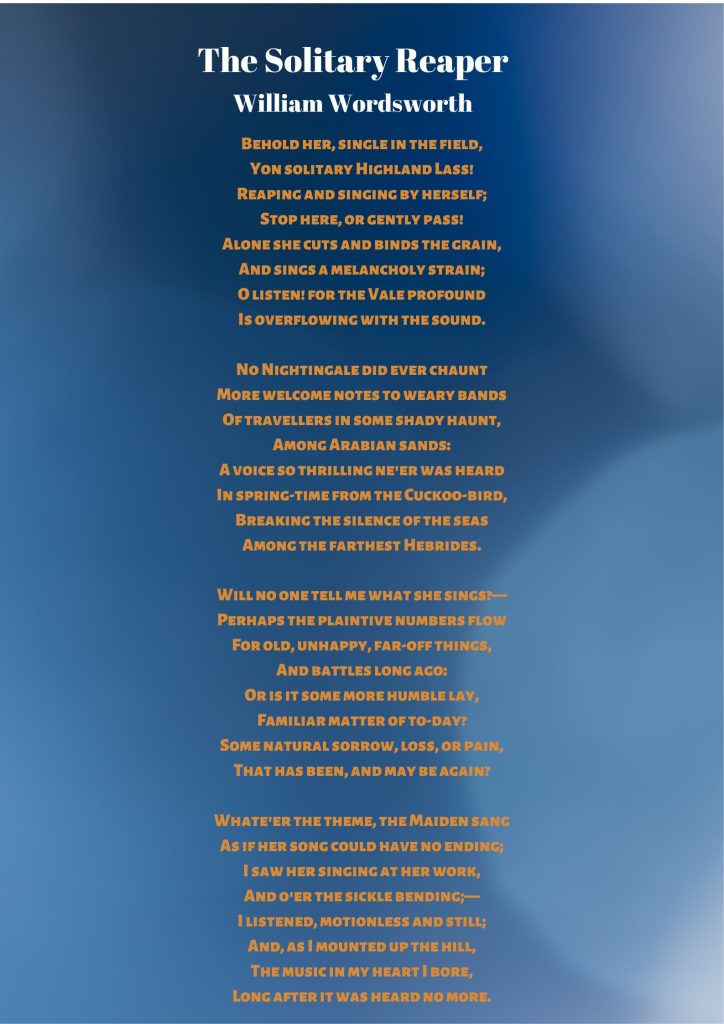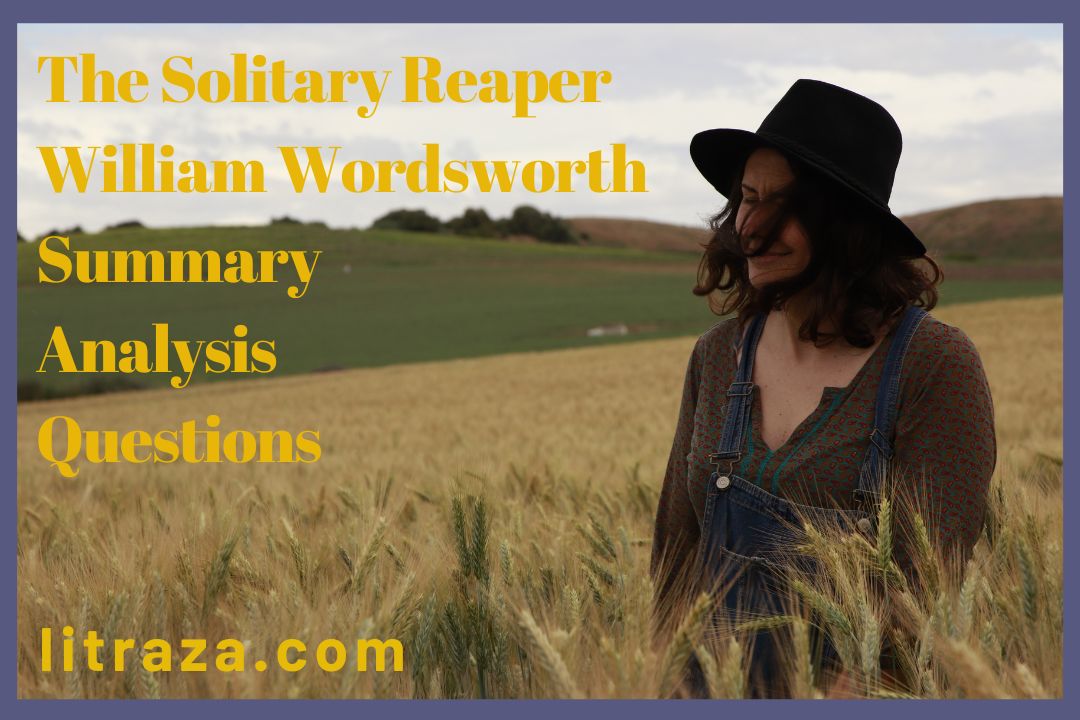Introduction
The Solitary Reaper by William Wordsworth is one of the most popular poems of the Romantic era. The poet relates a personal experience of passing by a field in the Highland. He sees a woman reaping the crop all alone in the field. She is also singing a song in her native language. The scene inspires William Wordsworth and he depicts it in this poem, The Solitary Reaper.
The Solitary Reaper by William Wordsworth is a frequently anthologized poem. It is a part of the English syllabi of the University of the Punjab and Sargodha University for BA/ADA students. This article, The Solitary Reaper by William Wordsworth – Summary Analysis Questions, will facilitate the students in their preparation for examinations. It will also assist the instructors who look for quality material on this topic.
The Poet
Wordsworth was on April 7, 1770, in Cockermouth, Cumberland, England. He was a representative poet of the Romantic era of English poetry. Wordsworth, in association with Samuel Taylor Coleridge, chartered the manifesto of the poetry of the Romantic age. Lyrical Ballads, which he co-authored with Coleridge, suggested a new outlook on English poetry. Wordsworth was an advocate of spirituality and man’s close connection with nature. He is famous as a poet and priest of nature. Wordsworth believed in nature as the most powerful inspiration for poetry. He used simple everyday diction which added to the appeal of his poetry. The Solitary Reaper is a practical example of Wordsworth’s poetic theory. Wordsworth became the Poet Laureate of England in 1843. He held the position till his death on April 23, 1850.
Text of the Poem The Solitary Reaper by William Wordsworth

Summary of the Poem The Solitary Reaper by William Wordsworth
Poet’s Encounter with the Solitary Reaper
The Solitary Reaper by William Wordsworth is about his encounter with a Highland lass. He happened to come across this peasant girl while passing through a valley. Wordsworth, with his sister Dorothy Wordsworth, visited Scotland in 1803. The incident may have taken place during the same tour.
The Song of the Solitary Reaper
Wordsworth observes that the solitary reaper is not only reaping the crop but also singing a song. It inspires the poet and he stands there listening to her captivating voice. The more he listens to her, the more he feels attracted to the voice. He feels as if the deep valley is overflowing with her beautiful voice.
Comparison with the Voice of the Cuckoo and the Nightingale
William Wordsworth compares the voice of the solitary reaper with the voice of the cuckoo and the nightingale. He declares that the voice of the peasant girl is more thrilling than that of the cuckoo singing in the spring season. Her voice is so powerful that it seems to break the silence of the seas. The poet praises the song of the peasant girl. He compares it to the nightingale’s song for the tired travellers in the oases of Arabian deserts.
The Poet’s Inability to Understand the Song
The song that the solitary reaper sings is in her native language. Therefore, the poet is unable to understand the meaning of the song. He asks if anybody can tell him what she sings. However, despite his inability to grasp the meaning of the song, the poet feels enchanted by her melancholy strain.
What Might Be the Theme of the Song?
William Wordsworth is unable to understand the language of the solitary reaper. But he tries to guess the theme of her song. The melancholy strain suggests that it is a sad song. She is perhaps singing about some unhappy event of the past, or it may be a familiar issue of today. It is also possible that she is singing about the battles of the past, or the song is about some personal loss.
Wordsworth’s Final Reaction to the Song
The song of the solitary reaper has a captivating influence on William Wordsworth. He wishes the song to go on forever. He suggests that the passers-by should not disturb the song. They should either listen silently or pass gently. The poet concludes the poem by saying that he heard this song a long time ago. But he still keeps it in his heart.
Important Questions
Q1: Write a critical analysis of the poem The Solitary Reaper by William Wordsworth.
Q2: Discuss The Solitary Reaper by William Wordsworth as a romantic poem.
Q3: What is the theme of the poem The Solitary Reaper by William Wordsworth?
Introduction
The Solitary Reaper by William Wordsworth is a beautiful poem. Wordsworth, as a great poet and priest of nature, explores beauty in the simplest objects of nature. He believes that true poetry is ‘a spontaneous overflow of powerful emotions’. To him, everything that is a part of nature and is in its original form may inspire man. In this poem, he describes his encounter with a Highland lass who is working alone in a field. She is singing a song that inspires the poet and he narrates it in verses. The poem revolves around the theme of the beauty of nature and natural activity. It also registers the importance of art in the form of the song of the solitary reaper.
Poet’s Abrupt Reaction
As soon as the poet sees the Highland peasant girl and listens to her melodious voice, he feels attracted to her. He wishes other passers-by to be as attentive as he is. They should observe how beautiful the scene and the song are.
Influence of the Song of the Solitary Reaper
The song of the solitary reaper casts a spell and transports the poet into the world of imagination. Imagination is the core characteristic of the romantic poet. The poet transcends the boundaries of time and place. He begins to compare the voice of the solitary reaper to that of the cuckoo. Notably, William Wordsworth addressed the cuckoo as a darling of the spring in another poem entitled, To the Cuckoo. He further draws a comparison between the song of the solitary reaper and that of the nightingale. It shows how deeply the song of this peasant girl has affected the poet. It reminds us of John Milton’s poem, To the Nightingale, in which Milton calls its notes fresh hopes for lovers.
Subjective Approach
The poets of the Romantic era laid great stress on subjectivity. In The Solitary Reaper, William Wordsworth has expressed extremely personal views about the song the Highland lass. To others, it may seem an ordinary event, but the poet brings out artistic qualities in the solitary reaper’s work and song.
Sensuous Imagery
Wordsworth employed sensuous imagery in The Solitary Reaper. It is again a significant trait of the poetry of the Romantic age. The image of ‘the vale profound’ that ‘is overflowing with the sound’ is a unique image. Similarly, the images of the ‘Arabian sands’ and ‘the farthest Hebrides’ also cast an alluring impact.
Appreciation of Art
William Wordsworth appreciates the art of the solitary reaper. Her voice and the strain of the song were so bewitching that the poet remembered them long afterwards. Although he could not understand a single word of the song, he felt the charm of her voice. It is the same universality of art that the Romantic poets advocated.
Conclusion
The Solitary Reaper by William Wordsworth is based on an everyday experience. But the poet presents it with such a remarkable poetic skill that we feel as if we were witnessing the scene with him. Sensuous imagery and pictorial quality enhance the romanticism of the poem.
Click the hyperlink if you are looking for an article on The Silken Tent by Robert Frost.




[…] her era, her poems contain very revolutionary ideas. Dickinson’s poetry reflects the influence of William Wordsworth and Ralph Waldo Emerson. Wordsworth was her favourite for the depiction of nature while Emerson was […]
[…] He was a philosopher, theologian, and political thinker also. Coleridge, with his friend poet William Wordsworth, founded the Romantic Movement. The publication of their collection of poetry Lyrical Ballads in […]